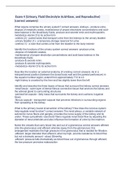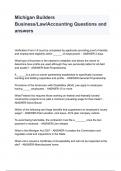-
1. Exam (elaborations) - Environmental science (correct answers)
-
2. Exam (elaborations) - The role of nutrition in our health (correct answers)
-
3. Exam (elaborations) - Nutrition and health (correct answers)
-
4. Exam (elaborations) - Disaster management questions (correct answers)
-
5. Exam (elaborations) - Botany-exam (correct answers)
-
6. Exam (elaborations) - Botany exam (correct answers)
-
7. Exam (elaborations) - Botany vocabulary (correct answers)
-
8. Exam (elaborations) - Zoology exam 1: chapters 1, 3, 4, 5, 6, 7 (correct answers)
-
9. Exam (elaborations) - Zoology (correct answers)
-
10. Exam (elaborations) - Introduction to zoology (correct answers)
-
11. Exam (elaborations) - Zoology vocabulary list (correct answers)
-
12. Exam (elaborations) - Branches of zoology (correct answers)
-
13. Exam (elaborations) - Zoology unit 1 (correct answers)
-
14. Exam (elaborations) - Computer science (correct answers)
-
15. Exam (elaborations) - Computer science package (correct answers)
-
16. Exam (elaborations) - Computer science package (correct answers)
-
17. Exam (elaborations) - Computer science test questions (correct answers)
-
18. Exam (elaborations) - Environmental science 1-4 (correct answers)
-
19. Exam (elaborations) - Environmental science 1-7 (correct answers)
-
20. Exam (elaborations) - Intro to actuarial science (correct answers)
-
21. Exam (elaborations) - Risk and its management intro actuarial science (correct answers)
-
22. Exam (elaborations) - Actuarial science vocabulary (correct answers)
-
23. Exam (elaborations) - Actuarial science derivatives (correct answers)
-
24. Exam (elaborations) - Ecology and terminology (correct answers)
-
25. Exam (elaborations) - Ecology unit (correct answers)
-
26. Exam (elaborations) - Ecological classification (correct answers)
-
27. Exam (elaborations) - Ib biology topic: ecology (correct answers)
-
28. Exam (elaborations) - Community ecology (correct answers)
-
29. Exam (elaborations) - Chemical engineering (correct answers)
-
30. Exam (elaborations) - Chemical engineering law (correct answers)
-
31. Exam (elaborations) - Engineering technology (correct answers)
-
32. Exam (elaborations) - Biochemistry (correct answers)
-
33. Exam (elaborations) - Psychology topics (correct answers)
-
34. Exam (elaborations) - Analytical chemistry (correct answers)
-
35. Exam (elaborations) - Analytical chemistry 1 (correct answers)
-
36. Exam (elaborations) - Applied science unit one biology (correct answers)
-
37. Exam (elaborations) - Btec applied science: biology (correct answers)
-
38. Exam (elaborations) - Btec applied science unit chemistry (correct answers)
-
39. Exam (elaborations) - electrical engineering chapter 11 (correct answers)
-
40. Exam (elaborations) - Electricity and electrical systems (correct answers)
-
41. Exam (elaborations) - Electrical engineering (correct answers)
-
42. Exam (elaborations) - Electrical engineering technology (correct answers)
-
43. Exam (elaborations) - Natural science (correct answers)
-
44. Exam (elaborations) - Natural science exam analysis (correct answers)
-
45. Exam (elaborations) - Medicine and health (correct answers)
-
46. Exam (elaborations) - Medicine and drugs (correct answers)
-
47. Exam (elaborations) - Community health (correct answers)
-
48. Exam (elaborations) - Community health and terms (correct answers)
-
49. Exam (elaborations) - Community health nursing exam (correct answers)
-
50. Exam (elaborations) - Radiology (correct answers)
-
51. Exam (elaborations) - Radiology practice test (correct answers)
-
52. Exam (elaborations) - Radiology exam (correct answers)
-
53. Exam (elaborations) - Dental radiology (correct answers)
-
54. Exam (elaborations) - Human anatomy and physiology chapter 1 (correct answers)
-
55. Exam (elaborations) - Acid, base and reproductive (correct answers)
-
56. Exam (elaborations) - exam 4 (urinary, fluid electrolyte acid-base, and reproductive) (correct answers)
-
57. Exam (elaborations) - Natural sciences (correct answers)
-
58. Exam (elaborations) - Natural science exam (correct answers)
-
59. Exam (elaborations) - Earth and environmental science exam (correct answers)
-
60. Exam (elaborations) - Earth and environmental science unit 1 (correct answers)
-
61. Exam (elaborations) - Earth and environmental science exam (correct answers)
-
Show more





